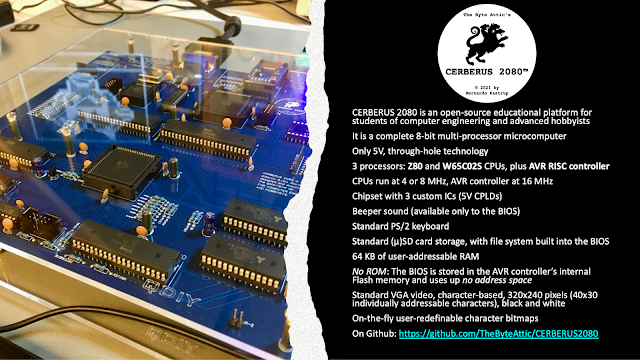For seven months, [Bernardo Kastrup] at [TheByteAttic] has been realizing his childhood dream of building his own computer. It was this dream that steered him into the field of computer design at the age of 17. After thirty years in the industry, he finally has some time to design the computer he dreamt about as a kid. His requirements are ambitious: fully open design, gate-level details, thru-hole or PLCC for easy hacking, well-established processors with existing tool chains, low-cost development tools for CPLDs, no FPGA, standard ITX case compatible, and so on. He quite reasonably decides to use more modern electronics for video (VGA), keyboard (PS/2), and program storage (flash drive). Along the way, he chooses to put three processors on the board instead of one:
- Zilog Z84C0010 (Z80)
- WDC W65C0256 (6502)
- AVR ATMEGA328 (RISC Controller)
When coming up with the concept and requirements, [Bernardo] had a fictitious alternate history in mind — one where there were follow-ups to the ZX80, PET/CBM, or TRS-80 from the late 1970s that were extensions to the original systems. But he also wanted a clean design, without cost-cutting gimmicks, in order to make it easier for learners to focus on computing itself — a didactic architecture, as he describes it. Turn the crank for seven long months, and we have the Cerberus 2080. [Bernardo] has put the design on GitHub, and made a video series out of the whole process, of which the introduction video is below the break. There’s even an online emulator developed by retro hacker [Andy Toone].
We wrote about the 6502-based ERIC-1 project back in 2014 which shared the bus with an ATMEGA simulating ROM. The Minty Z80 project from 2019 also uses a similar technique. Thanks to [Frédéric] for sending us the tip.
















Ohio Scientific had the Challenger III systems. A ZIP for CP/M, a 6502 for OS65U and 6800 for why not?
http://www.technology.niagarac.on.ca/people/mcsele/hobby/ohio-scientific-computers-challenger-iii-oem/
A lack of hardware resources in comparison with people meant that the 1970s and 1980s were a heyday for architectural creativity, with barely any two computers being able to run each other’s programs even if they had the same CPU. They had wildly different memory maps, speeds; video / tty, audio, storage and versions of BASIC (which could be seen as an anti-standard).
So, this generation of systems provides ample inspiration for other fantasy computers, languages and CPUs. Cool!
The Digital Group had a system that could take different CPU boards but I don’t think at the same time. That was around 1977.
When the Radio Shack Color Computer III was taken off the market, there were a few computers promoted as the next step. Some were 6809 based but improved, while one or two went to the 68000. It was a continuum, unlike recent projects to reproduce the TI or Commodore in a small package.
In some ways things went really slow for ten years after the Altair 8800. Nobody knew where things were going, so lots of operating systems and different hardware. Things not generally talked about now because they made so little impact then, and are lost by the louder things.
It’s only looking back that things went so fast.
I actually had put money down to purchase an ECD MicroMind as my first computer. Unfortunately, they appeared to stop working on it in favor of developing an advanced terminal for business use. Their ads in Byte magazine just kept saying, “Oh, we’re really busy. It’ll be a while before we ship any computers, but trust us.”
It would have been an interesting system, with the potential for up to 15 processors plugged into the backplane simultaneously.
I ended up getting my money refunded shortly before they went under, and bought an early Apple 2.
I’d love to hear more about that story. I went on a trip to Boston and chatted with some of the principals.
The multi-processor version was an interesting concept, but not delivered.
The company went out of business because of a single (large) customer cancelling their order, and the resulting cash crunch drive the company into bankruptcy. I was told they had to tinker with their bus architecture
A few people who got early systems ended up using them for interesting projects, John Holland – of UMich – was an early user. The early machines were wire-wrapped, and the PCB version of the Micromind wasn’t able to be completed in time, as I recall.
mainboard is no problem, problem is with power (mobility) , screen, keyboard and small.
Look at Ello 2 computer or psion 5
tell me how long this main board work on 0.3 Wh